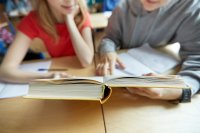Improving Reading Outcomes for Economically Disadvantaged Students
A teacher at a Title I school shares classroom and school-wide strategies to improve students’ reading trajectories.
Your content has been saved!
Go to My Saved Content.For an elementary school teacher who works with economically disadvantaged students, it can be discouraging to hear phrases like “significant achievement gap” or “30-million-word gap” in discussions of the reading and vocabulary development of our students. But research does bear those phrases out: There are clear trends of underachievement in academics for students of low socioeconomic status (SES).
I’ve taught in a Title I school in Northern Virginia for six years, with experience in fourth through sixth grades, and year after year, I work with students who are reading drastically below grade level. There are many things that affect my students that I can’t control, but research has shown that strong, intentional, and explicit instruction can positively impact the reading trajectories of all students, especially those with economic disadvantages.
Low SES status alone is not a strong predictor of reading achievement, but when combined with other factors—such as a non-literacy-rich home environment, poor classroom instruction, or being an English language learner—the chances of reading difficulties increase. This is often referred to as “double disadvantage”: The poorest students often attend schools with the fewest resources.
Teachers in these schools have been found to use less complex vocabulary with their students, hold them to lower expectations, and provide less explicit instruction. Without clear instruction and high expectations, how can students succeed?
The Backbone of Literacy Instruction
Teachers have the day-to-day responsibility of fostering a love of reading, providing meaningful instruction, and thus improving student outcomes. In fact, teacher instruction is one of the most important factors attributed to student success. By holding students to high expectations, asking challenging questions, involving students in their learning, and explicitly modeling good reading habits, teachers can help all students improve their reading outcomes. It isn’t only what teachers teach, but how they teach that ultimately matters.
Intentional and explicit planning is the backbone of literacy instruction. Teachers should be intentional with book choice, questions and prompts, student partnerships, and classroom environment. For example, when choosing a book, a teacher might consider whether it will catch students’ interest and whether it has relatable characters and experiences for their students, while also allowing for their teaching point. Being intentional with book choice can help increase student engagement.
When planning stopping points, we can give students opportunities to talk with a reading partner before a whole group share. Doing this multiple times throughout a lesson will allow all voices to be heard. After the reading and writing block, it’s a good idea to have students come back together to reflect on their learning—this allows the teacher to see how students took the learning objective and applied it to their reading.
Increasing Student Access to Books
School-wide programs should be put in place to give students more access to books and parents more knowledge about how we are teaching their children. Community literacy nights are a way to provide meaningful resources to parents and students. While it may be challenging to engage families in literacy nights, hosting such events in common community centers such as apartment club houses or the public library can increase participation.
Schools can incentivize attendance by providing food and holding raffles for books or practical needs such as gift cards or coupons from local grocery stores or department stores.
Summer reading programs are another way to support home literacy for students. The public librarian could come to the school to advertise and get students excited for summer reading—it might even be possible to sign them up for library cards while they’re at school. Another option is setting up a Recycled Reading program, in which students trade in their own already-read books for another to keep.
By providing students with access to new books, these programs can help foster a love of reading.
The obstacles to student learning can seem endless. Poverty is often considered one of these obstacles, but it doesn’t need to be. Even when poverty is combined with other risk factors, effective interventions put in place by schools and teachers can positively impact a student’s reading trajectory.
